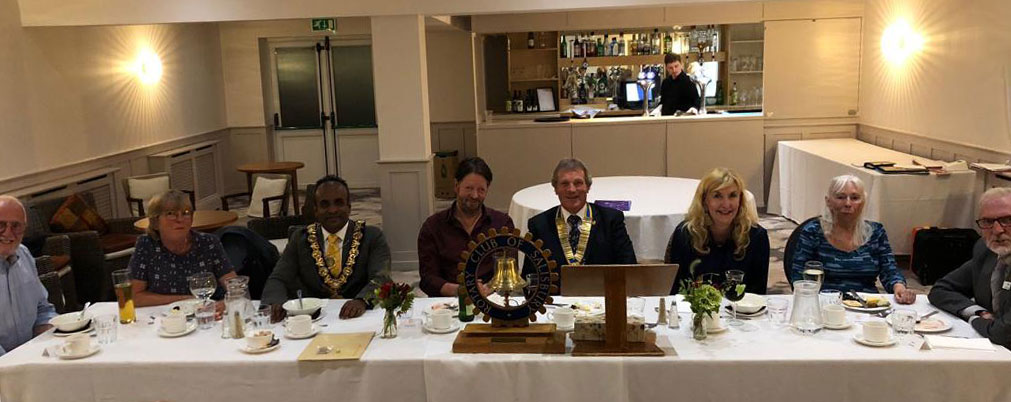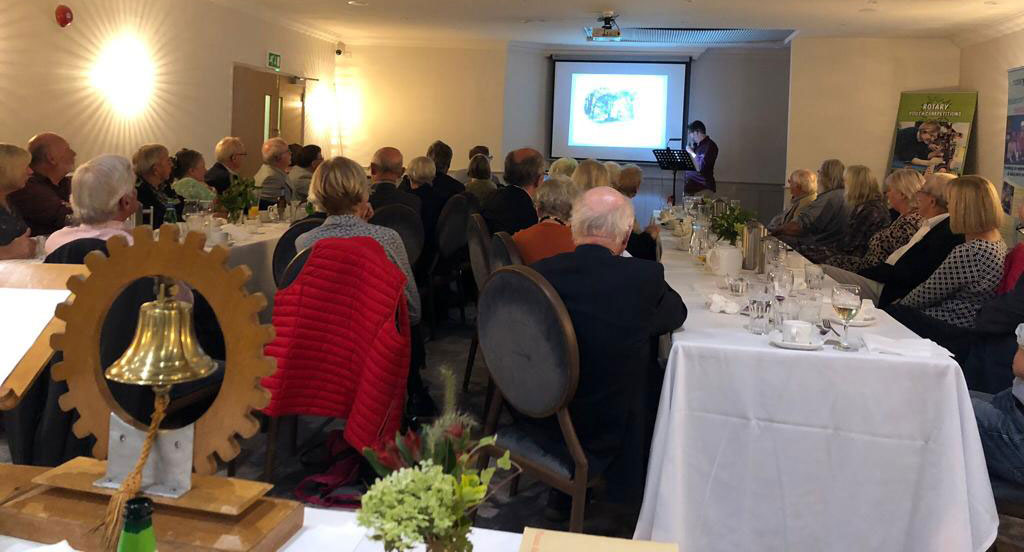The Madhouse Visits Salisbury Rotary Club

Salisbury Rotary Club welcomed The Right Worshipful the Mayor of the City of Salisbury, Councillor Mr Atiqul Hoque, and a large number of Salisbury Rotarians and guests to listen to Salisbury’s very own award winning history expert, Frogg Moody.
Frogg’s topic was ‘Fisherton House Asylum and My Time There as Head Gardener.‘ Frogg was employed at The Old Manor Hospital where he spent many years as Head Gardener, and became interested in its history and, in particular, the Victorian horticulture therapy introduced as a means of treatment.
Frogg talked about the history of the Asylum advising that it was established in the early 19th century as a private licensed house called Fisherton House or Fisherton House Asylum (known as the Salisbury Mad House), which became the largest private madhouse in the United Kingdom. It received its first patient in January 1813 and, by 1837, had 100 inmates, including 66 paupers under Superintendent, Charles Finch. Later on, many soldiers, suffering from shell shock, became patients during and after World War 1.
Laverstock House had also been purchased in 1779 as an additional home for patients and, in 1924, following a change of proprietors, The Asylum was renamed the Old Manor Hospital before, in 1955 being amalgamated into the National Health Service.
In the Asylum’s early days, doctors had little understanding of what caused mental illness and their prescriptions for treatment were based on personal experience. Physical restraint was a common method of controlling dangerous behaviour, either by leg mana

cles, handcuffs or straitjackets, but these had been largely discontinued by 1847. Among other treatments later recorded in use in Fisherton House in the mid-19th century were cupping, blistering, purging, diuretics, bleeding and the giving of various unspecified drugs. Some patients were subject to induced vomiting twice a week. For mania, a tartar emetic “worked briskly”, arsenic, opium and creosote were also used
Operational therapy was also introduced through farming and developing the vast gardens and grounds owned by the Asylum.
The Old Manor Hospital closed in 2003 and was replaced by Fountain Way, a smaller, modern, psychiatric hospital on part of the same site. In 2014 the site was acquired by Quantum Group for development as a residential estate.
Frogg had been employed as a landscape gardener before being persuaded by his father (who worked at the Asylum as a painter, decorator and sign writer) to apply for a job as gardener at The Old Manor. On appointment, Frogg earned £8 per week and lived in the top floor of Montague House (one of the nurses’ homes).
When Ken Toogood in 1988, the Head Gardener retired, Frogg was appointed as his successor (the best job he has ever had) and introduced horticultural therapy for the patients which involved working in the farm grounds, gardens and greenhouses growing vegetables, flowers and shrubs and looking after the cattle, pigs, sheep and hens. He also set up links with local schools and arranged training for patients at Reading college.
An excellent talk by Frogg, wonderfully illustrated by slides of the buildings and grounds that we all used to pass on the Wilton Road, and think nothing much about their past history. Now we know.
News
- SALISBURY ROTARY CLUB WELCOMES SPIRE HOMECARE AS ITS FIRST CORPORATE MEMBER
President of the Rotary Club of Salisbury, Peter Mitchell, was… - CLARENDON PALACE COMES TO LIFE AT SALISBURY ROTARY CLUB
Salisbury Rotary Club members were enthralled at a recent meeting… - SALISBURY ROTARY INSTALLS ANOTHER LIFE SAVING DEFIBRILLATOR
Salisbury Rotary Club was delighted to fund the installation of… - SALISBURY ROTARY YOUNG MUSICIANS WINNERS
Godolphin School was the venue for the Rotary Wessex District… - SALISBURY ROTARY CLUB WELCOMES A NEW MEMBER
President of the Rotary Club of Salisbury, Peter Mitchell, was… - View all News
Events
- Salisbury Rotary Supporting The Clarendon Marathon in 2022
Full Marathon / Half Marathon / Relay (x4) /… - View all Events